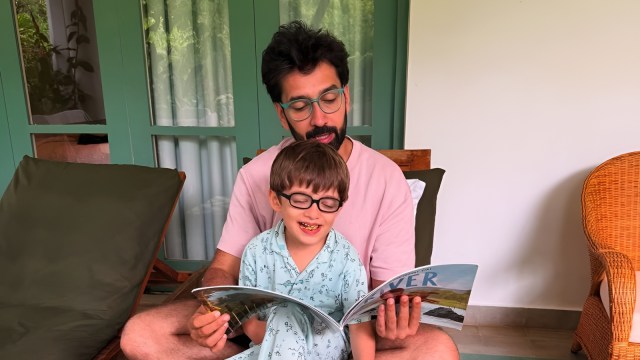📣 For more lifestyle news, click here to join our WhatsApp Channel and also follow us on Instagram
‘It can sometimes really break my heart’: Nakuul Mehta opens up about the ‘pain of being the second preferred parent’; ways to rebuild bond
"For a while, I told myself it’s because she carried him ... but the truth is, that bond isn’t only about pregnancy or breastfeeding. It’s about showing up"
 'I’ve learnt that being the second parent doesn’t mean you’re any less. It just means you have to keep showing up,' says Nakuul Mehta
'I’ve learnt that being the second parent doesn’t mean you’re any less. It just means you have to keep showing up,' says Nakuul MehtaTelevision actor Nakuul Mehta recently poured his heart out on his parenting podcast, The Indian Parent POD Sufi and Folks, where he acknowledged that the pain of being the second-preferred parent is real. Mehta shared how this made him feel and what active steps he is taking to manage the situation wisely.
In a candid confession, he told his co-host and wife, Jankee Parekh Mehta: “In all the fun things, he is always looking out to do it with his daada. When he is in agony, he will bypass me and just run to you. It can sometimes really break my heart”
The couple also shared that they try to strengthen Nakuul’s bond with their son by ensuring that the three-year-old does all the “outdoor activities” with his father, and that Jankee takes a voluntary step back on many things, like “bedtime and bath time,” to give the duo more time together.
Taking a cue from the Mehtas, we decided to reach out to Neha Cadabam, Senior Child Psychologist at Cadabams Mindtalk, to better understand why kids sometimes lean more towards one parent and how the parent should handle it.
View this post on Instagram
1. Why do children naturally gravitate toward one parent more than the other?
The psychologist explains that children’s attachment preferences are shaped by emotional attunement: “the parent who instinctively ‘gets’ their moods, comforts them effectively, and responds consistently becomes their psychological anchor.” They don’t just attach based on time spent, but on the quality of emotional responsiveness.
Sometimes, preference may also reflect temperament matching. “For example, an introverted child may feel safer with a quieter parent, or a spirited child may lean toward the one who engages playfully,” Cadabam notes. She further adds that developmental phases also play a role: toddlers might prefer the nurturing parent, while adolescents gravitate toward the one offering autonomy. “It’s not rejection; it’s simply the child’s evolving emotional need for safety, validation, or freedom,” she assures.
2. How does this affect the emotional well-being of the parent who feels left out?
According to the psychologist, feeling like the “second choice” can sting deeply. It may trigger feelings of inadequacy, jealousy, or guilt, affecting the parent’s self-esteem, especially, especially if they interpret the child’s behavior as personal rejection. “Left unacknowledged, this emotional hurt can lead to withdrawal or overcompensation — either distancing from the child or trying too hard to “win” their affection, both of which can reinforce the divide.” Cadabams assures that the parents should understand that a “child’s preference is fluid, situational, and never a verdict on parental love or competence.”
3. Is parental preference a normal developmental phase or a sign of deeper attachment issues?
Cadabams assures that in most cases, it’s completely normal and temporary. As per science, parent-preference peaks between ages 2–6 and again in adolescence — both times when children assert independence and test relational boundaries. “However, if the preference is rigid, prolonged, or paired with fear or hostility toward the other parent, it may signal an insecure attachment pattern or environmental stress — for instance, inconsistent discipline, marital conflict, or emotional unavailability.” In such cases, family therapy or parent-child interaction therapy (PCIT) can help rebalance emotional security.
4. How can the “less preferred” parent respond and rebuild a connection without guilt or resentment?
- First, resist the urge to turn it into a competition. Children easily sense emotional tension and guilt, which can make them anxious or manipulative when managing affection. Instead, focus on connection, not correction.
- Be consistent, not overbearing: Maintain gentle, reliable routines — bedtime stories, school drop-offs, or shared hobbies. Predictability builds safety.
- Mirror emotions, not demands: Say, “I can see you’re upset” instead of “Why don’t you love me as much?” Empathy invites closeness.
- Avoid triangulation: Don’t make the preferred parent a rival. Collaborative parenting models healthy emotional regulation.
- Reframe your worth: Attachment researcher Dan Siegel often says, “Connection, not perfection, is what children remember.” You’re not being replaced — you’re part of a dynamic that will evolve.
- If guilt or resentment lingers, therapy can help the parent process these feelings without letting them shape the relationship narrative.
📣 For more lifestyle news, click here to join our WhatsApp Channel and also follow us on Instagram



- 01
- 02
- 03
- 04
- 05
























